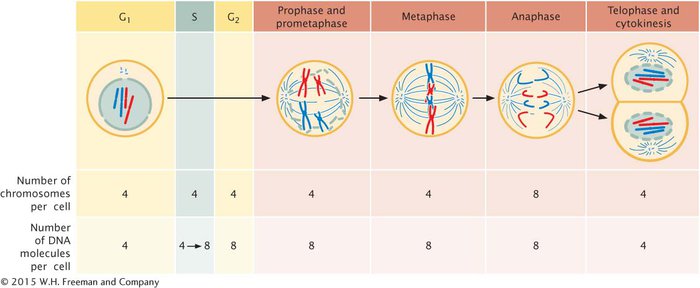Genetic Consequences of the Cell Cycle
What are the genetically important results of the cell cycle? From a single cell, the cell cycle produces two daughter cells that contain the same genetic instructions. The resulting cells are genetically identical with each other and with their parent cell because DNA synthesis in the S phase creates an exact copy of each DNA molecule, giving rise to two genetically identical sister chromatids. Mitosis then ensures that one of the two sister chromatids from each replicated chromosome passes into each new cell.
Another genetically important result of the cell cycle is that each of the cells produced contains a full complement of chromosomes: there is no net reduction or increase in chromosome number. Each cell also contains approximately half the cytoplasm and organelle content of the original parent cell, but no precise mechanism analogous to mitosis ensures that organelles are evenly divided. Consequently, not all cells resulting from the cell cycle are identical in their cytoplasmic content.
CONCEPTS
The active cell cycle phases are interphase and the M phase. Interphase consists of G1, S, and G2. In G1, the cell grows and prepares for cell division; in the S phase, DNA synthesis takes place; in G2, other biochemical events necessary for cell division take place. Some cells enter a quiescent phase called G0. The M phase includes mitosis, which is divided into prophase, prometaphase, metaphase, anaphase, and telophase, and cytokinesis.
 CONCEPT CHECK 4
CONCEPT CHECK 4
Which is the correct order of stages in the cell cycle?
G1, S, prophase, metaphase, anaphase
S, G1, prophase, metaphase, anaphase
Prophase, S, G1, metaphase, anaphase
S, G1, anaphase, prophase, metaphase
a
CONNECTING CONCEPTS
Counting Chromosomes and DNA Molecules
The relations among chromosomes, chromatids, and DNA molecules frequently cause confusion. At certain times, chromosomes are unreplicated; at other times, each chromosome possesses two chromatids (see Figure 2.6). Chromosomes sometimes consist of a single DNA molecule; at other times, they consist of two DNA molecules. How can we keep track of the number of these structures in the cell cycle?
There are two simple rules for counting chromosomes and DNA molecules: (1) to determine the number of chromosomes, count the number of functional centromeres; (2) to determine the number of DNA molecules, first determine if sister chromatids are present. If sister chromatids are present, then the number of DNA molecules is twice the number of chromosomes. If the chromosome is unreplicated, without sister chromatids, the number of DNA molecules is the same as the number of chromosomes.
Let’s examine a hypothetical cell as it passes through the cell cycle (Figure 2.10). At the beginning of G1, this diploid cell has two complete sets of chromosomes, for a total of four chromosomes. Each chromosome is unreplicated, without sister chromatids, so there are four DNA molecules in the cell during G1. In the S phase, each DNA molecule is copied. The two resulting DNA molecules combine with histones and other proteins to form sister chromatids. Although the amount of DNA doubles in the S phase, the number of chromosomes remains the same, because the two sister chromatids are tethered together and share a single functional centromere. At the end of the S phase, this cell still contains four chromosomes, each with two chromatids; so there are 4 × 2 = 8 DNA molecules present.
Through prophase, prometaphase, and metaphase, the cell has four chromosomes and eight DNA molecules. At anaphase, however, the sister chromatids separate. Each now has its own functional centromere, and so each is considered a separate chromosome. Until cytokinesis, the cell contains eight unreplicated chromosomes, without sister chromatids; thus, there are still eight DNA molecules present. After cytokinesis, the eight chromosomes (and eight DNA molecules) are distributed equally between two cells; so each new cell contains four chromosomes and four DNA molecules, the number present at the beginning of the cell cycle.
In summary, the number of chromosomes increases briefly only in anaphase, when the two chromatids of a chromosome separate and become distinct chromosomes. The number of chromosomes decreases only through cytokinesis. The number of DNA molecules increases only in the S phase and decreases only through cytokinesis.  TRY PROBLEM 23
TRY PROBLEM 23
